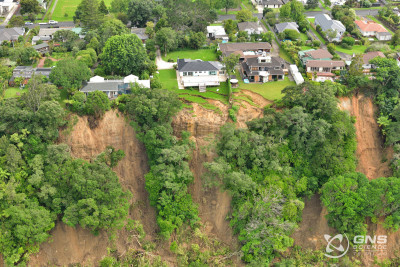Toka Tū Ake EQC awards $1.2 million for research to boost New Zealand’s resilience to natural hazards
Toka Tū Ake EQC (Earthquake Commission) has awarded 14 research teams a total of more than $1.2 million in this year’s Biennial Grants round. These research projects aim to help better understand our natural hazard risks and find ways to reduce the impact of those hazards.
Toka Tū Ake EQC wants to ensure natural hazard resilience becomes embedded in all aspects of decision-making for homes, towns, and cities in Aotearoa New Zealand. Investing in research and translating that will reduce our vulnerability to natural hazard events.
The Biennial Grants have been running since 1989 as part of our contestable funding and are awarded every two years. Successful grants are aligned with the Toka Tū Ake research investment priorities, including research that empowers people, quantifies hazards and their impacts, looks at smarter land use, governance and economics and resilient buildings. This year there were nearly 80 expressions of interest.

Slope instability and landslips after February 2023 floods in Auckland; Photo credit Chris Massey, GNS Science.
Head of Research Dr Natalie Balfour says each of the 14 research projects will help understand New Zealand’s natural hazard risk and reduce the impact on people and property when events do happen.
“The successful projects cover most of our natural hazards from volcanoes to landslides, and many of the projects incorporate effects of climate change on these hazards, such as one on ‘slope hazard hotspots in Aotearoa’s changing climate’.
Some also include mātauranga Māori or are led by Māori researchers, such as one project about coastal inundation losses on Māori assets in the southern Marlborough district which will integrate Te Ao Māori with contemporary science to analyse coastal inundation losses for adaptive resilience.”
“Investing in science and research is critical, as is translating it into tangible and appropriate outputs for others to use. If we can put sound data and research into the hands of key decision-makers like policy makers, local councils, designers, engineers, builders and most importantly, the New Zealand public, that’s when we can start making a difference.,” Dr Balfour says.
She said results from previous Toka Tū Ake investments have led to new building design guidance for engineers, identifying at-risk land, and detailed information for planners and emergency managers about the likely impacts of natural hazards across the country.
This year Toka Tū Ake continued special allocations to ensure there are more opportunities for Māori relevant research and early-career researchers.
“We were delighted with the response to this year’s grant round and pleased to be supporting fantastic projects that broaden the focus of our research programme to deliver new knowledge for Aotearoa New Zealand’s resilience. The quality of the proposals was exceptionally high.”
Along with funding the Biennial Grants, Toka Tū Ake invests in research at universities across New Zealand, supports regional and community organisations in research on natural hazards and risk reduction, as well as contributing to systems and programmes such as the GeoNet New Zealand’s natural hazard monitoring system.
Background information about the Toka Tū Ake EQC Biennial Grants
- Biennial Grants have been running since 1989 and have provided around $8 million in funding for more than 250 projects over the years.
- Every two years, Toka Tū Ake invites experienced and emerging researchers to submit proposals for Biennial Grant public good research (available for public use) as defined by the Earthquake Commission Act 1993(external link) and Toka Tū Ake EQC research investment priorities statement(external link) (external link).
Projects fall into five categories:
- How people perceive and manage risk (empowering people)
- Building and infrastructure performance (resilient buildings)
- Land-use management (smarter land-use)
- The governance and economics of disaster risk and disaster risk management (governance and economics
- Quantifying the size and frequency/likelihood of hazards and their impacts. (quantifying hazards and their impacts).
Full list of successful Biennial projects
Research project title |
Principal Investigator |
Host Institution |
| Cascading coastal inundation losses on Māori assets in the southern Marlborough district: Integrating Te Ao Māori with contemporary science to quantify compounding coastal inundation losses for adaptive resilience | Dr Shaun Williams | NIWA |
| A history of fault activity in the vicinity of Aotearoa’s supervolcano | Dr James Muirhead | University of Auckland |
| Virtually flooded: Improved risk communication through immersive virtual reality | Prof Matthew Wilson | University of Canterbury |
| Dynamic Volcanic Ash Damage Forecasting for Aotearoa-New Zealand | Dr Josh Hayes | GNS Science |
| Geophysical imaging of the Paeroa Fault for improved earthquake modelling | Dr Brook Keats | GNS Science |
| Geological Modelling the Hamilton Basin to Improve Earthquake Ground Motion Simulation | Dr Andrew La Croix | University of Waikato |
| High spatial resolution simulation platform for integrating land use, economics, and infrastructure | Dr Robert Cardwell | Market Economics Ltd |
| Insurance settlement following the 2016 Kaikōura/Hurunui earthquake: a comparison of rural, town and city claimant experiences and behaviours | Mr Cameron Eade | Resilient Organisations |
| Comparative Analysis of Lifetime Costs: Base Isolated Buildings vs. Conventional Buildings | Dr Alex Shegay | University of Auckland |
| Slope hazard hotspots in Aotearoa's changing climate | Dr Katherine Yates | University of Canterbury |
| Lava flow impacts on buildings and infrastructure: taking lessons from La Palma to New Zealand | Dr Geoff Kilgour | GNS Science |
| InSAR monitoring of slopes to build back safer | A/Prof Martin Brook | University of Auckland |
| A national landslide risk assessment for residential housing | Dr Tom Robinson | University of Canterbury |
| Quantifying corrosion to improve Aotearoa’s built environment resilience to future volcanic eruptions | A/Prof Carol Stewart | Massey University |